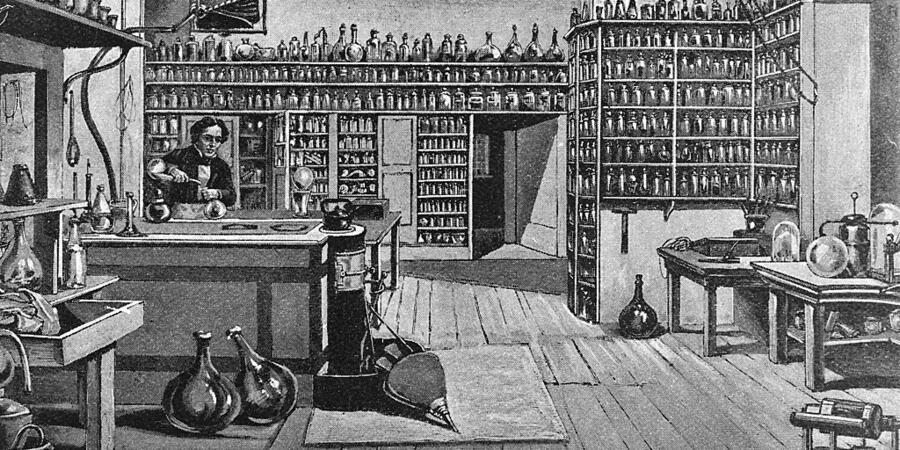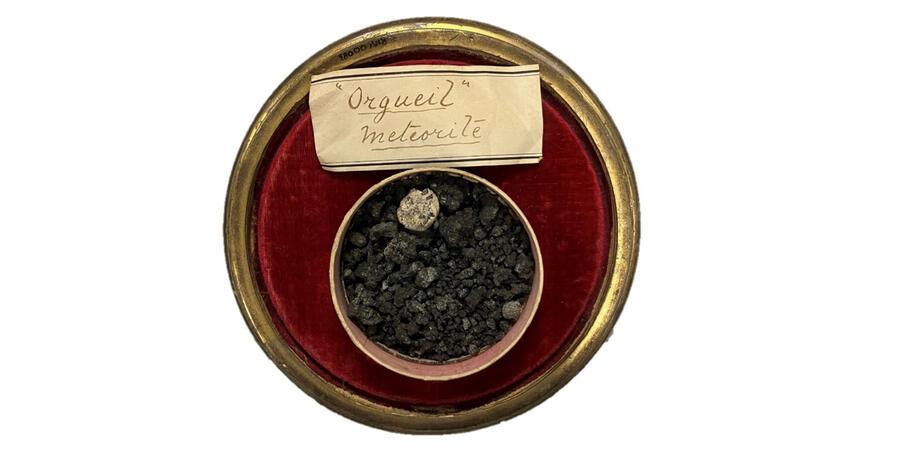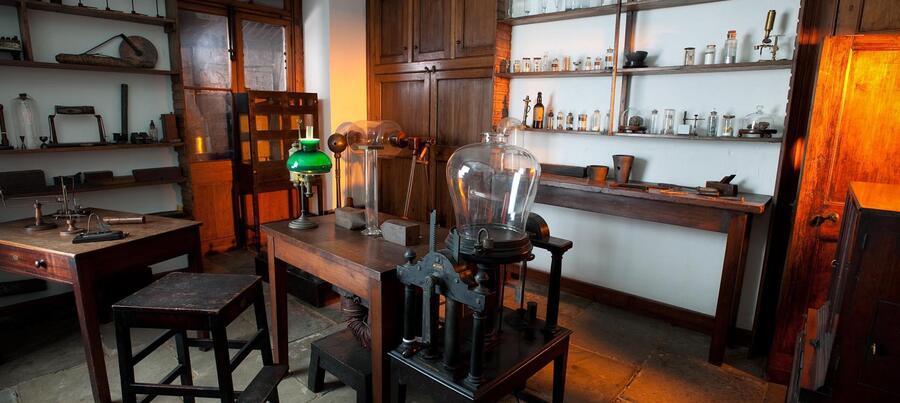Michael Faraday’s laboratory at the Royal Institution contains a variety of scientific equipment and specimens that you might expect for someone who studied electromagnetism, electrolysis, and electrochemistry. However, something that you may not have expected Faraday to have in his laboratory is a meteorite.
Securely placed in a glass jar is a piece of the meteorite Orgueil (meaning "pride" in French). The meteorite fell near Montauban in France on the 14th of May 1864. The fall was a spectacular event seen all over western France, and a total mass of 14 kg was recovered—Faraday had fragments weighing a total of ~25 g.
We are currently unable to trace how Faraday came to have Orgueil in his possession. It's not mentioned in any of the Ri's discourses, or in any of Faraday’s letters. However, we do know for certain that it belonged to Michael Faraday, as John Tyndall numbered it as part of Faraday’s collection, and the label on the sample is very similar to Faraday’s own handwriting. Regardless of how he obtained Orgueil, it is likely that Faraday did not know how special this tiny piece of rock would come to be for Planetary Scientists all around the world.
Orgueil is of high scientific interest and is now one of the most studied meteorites.

In 2000, Orgueil was classified as a carbonaceous chondrite. Carbonaceous chondrites are a class of meteorite which, as you might deduce from their name, are carbon-rich. However, this is somewhat misleading.
This class of chondrite was originally assumed to be carbon-rich based on its black/gray appearance. Although some of the meteorites in this class do contain high amounts of carbon, their contents overlap with other classes of chondrites.
Carbonaceous chondrites are subdivided into six groups. Orgueil is in the CI (Ivuna-like) group which is defined based on chemistry, a high degree of hydration, and the absence of inclusions which contain high contents of refractory elements such as calcium and aluminium. Other classified CI chondrites include Alais (France, 1806), Tonk (India, 1911), and the Antarctica meteorite Yamato 980134.
Statistically, CI chondrites such as Orgueil are rare as they fall to Earth less often than other meteorite groups. Since its fall in 1864, numerous scientific analyses have been conducted on Orgueil as it yielded the most material than any CI chondrite and therefore has provided scientists with more material for analysis.

Analyses of Orgueil have shown that, similarly to other CI chondrites, it has a chemical bulk composition similar to the Sun's photosphere and is therefore primitive. CI chondrites are typically used as a "cosmic reference" as they are inferred to represent the composition of the solar nebula and the starting materials from which the planets could have formed.
One of the most intriguing aspects of Orgueil is that it contains a diversity of organic compounds such as amino acids, carboxylic acids, nucleobases, and hydrocarbons. While none of the organics in Orgueil are biological in origin, they are known to be potential precursors to life.
Orgueil is also rich in water. The minerals in Orgueil show a high degree of aqueous alteration— most of the primary minerals have been replaced by secondary phases as a result of alteration by water. Scientists believe that these secondary phases were formed as a result of hydrothermal alteration on Orgueil’s parent body within the first few million years of the Solar System. Studying secondary phases such as this is essential to our understanding of fluid-rock interactions in the early Solar System.
Chondritic meteorites such as Orgueil originate from asteroids.
Chondrites are some of the oldest rocks we have access to as they formed ~4.56 billion years ago at the very start of our Solar System. However, despite Orgueil being classed as a chondrite, its origin has been highly debated within the scientific community. In 2006, a group of scientists reconstructed the orbit of Orgueil before it fell to Earth using observations from its trajectory noted at the time. They constrained an orbit which extended beyond Jupiter which is not the usual orbit expected for an asteroid as they are found between the orbits of Mars and Jupiter. This led some scientists to believe that Orgueil had a cometary origin.
In 1999, NASA launched the Stardust Mission to the comet Wild 2 which originated from the Kuiper belt. Five years later, Stardust collected comet and interstellar dust from Wild 2 and later returned it to Earth. Analysis from the material collected showed that solids present in the Wild 2 comet were similar to carbonaceous chondrites such as Orgueil which was unexpected.
However, isotopic analyses of the water present in the Wild 2 comet were vastly different to that of Orgueil and therefore a cometary origin was ruled out. In 2010, the EPOXI mission which was part of NASA’s Deep Impact mission did a flyby of the Jupiter family comet Hartley 2. Isotopic analysis of water present in Hartley 2 revealed that it was very similar to the isotopic composition of the water in Orgueil and other CI chondrites. This suggests that there is a link between the CI chondrites and some comets which is now gaining ground in the scientific community.

Although we are not sure if Faraday had any direct links with studying Orgueil, he did have previous experience studying meteorites. In 1839 he sent a letter addressed to Sir John Herschel which included his observations and preliminary results of the Cold Bokkeveld meteorite which fell in South Africa in 1838. The Cold Bokkeveld meteorite, similar to Orgueil, is a carbonaceous chondrite but is of a different group as it is a CM (Mighei-like).
In addition to Faraday's connection to meteorites, other scientists at the Royal Institution also engaged in Planetary Science. In 1863 and 1866, Alexander Herschel delivered discourses on meteorites called "On Luminous Meteors" and "On the Shooting-stars of the Years 1866-67." In 1885, James Dewar's Christmas Lectures featured meteorites which can from India.
158 years after its fall, Orgueil remains an intriguing rock that is continually helping scientists understand the processes which occurred during the formation of our Solar System.

Visit Faraday's laboratory
Kept in the same spot where the great natural philosopher worked is an accurate replica of his lab, featuring original objects that were used by Faraday, including some of his major discoveries and key apparatus such as the electric motor, homopolar generator and the giant electromagnet he used in his diamagnetic research.
About the author
Aimee Smith is a Planetary Science PhD graduate from The University of Manchester. She previously worked as a Presenter in the L’Oréal Young Scientist Centre in the Ri.